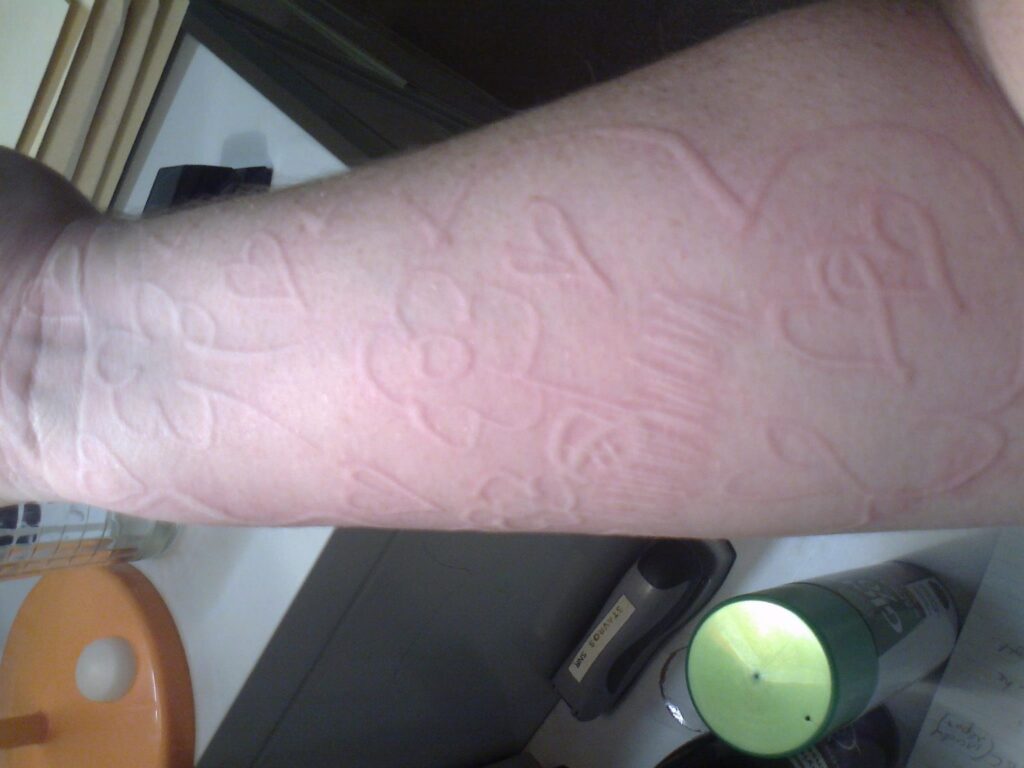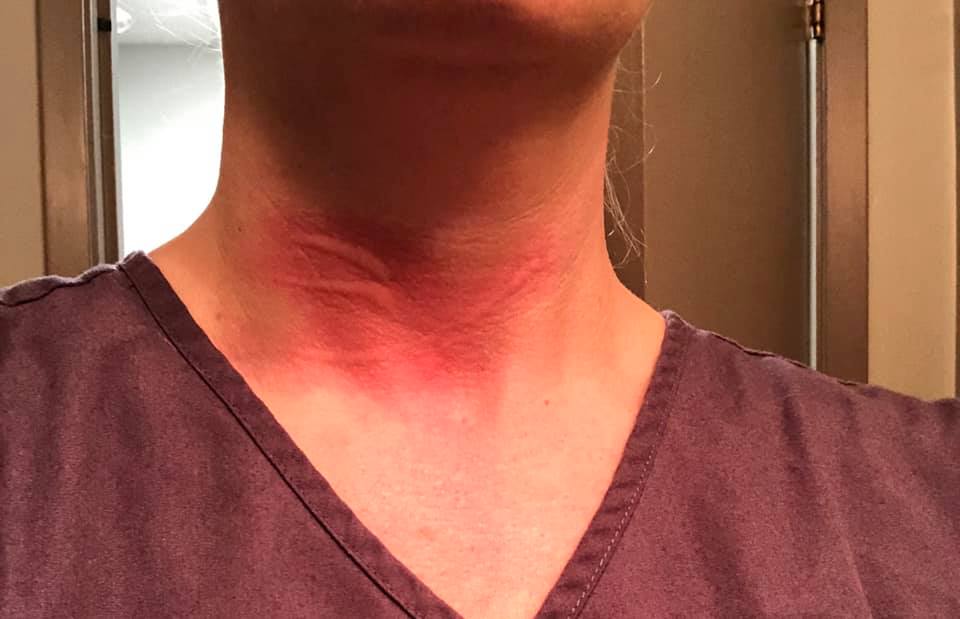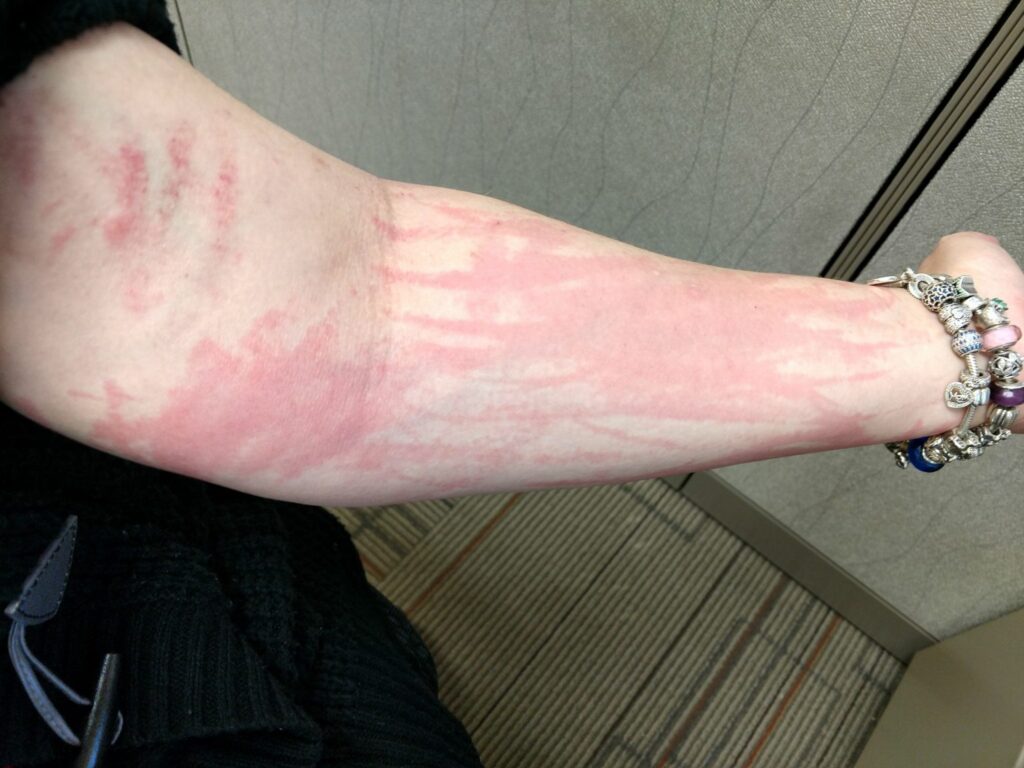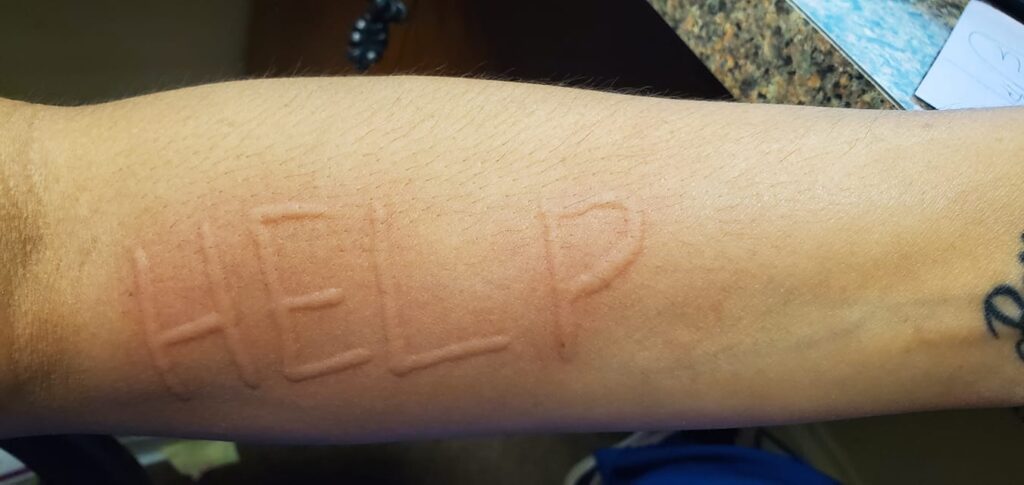Dermatographia is best understood in a photo. It is hard to explain but easy to see. Once you see it, you will begin to notice it other places. Mostly, you will see pictures of people’s skin. You can find it on the arms, back, neck, or even the shoulders. Ultimately, dermatographia can be seen anywhere but here are the most common areas for skin writing:
- Head and neck (especially under the chin)
- Back and shoulders
- Forearms and wrists
- Stomach
- Legs and calves
If you feel like sharing, the goal of this website is to build a community to support each other. So, please consider sharing your story. And if you have ever wanted to learn more about Dermatographia, I wrote a book about what we have learned. 100% of the proceeds go to funding and supporting this community.

Sometimes referred to as ‘skin writing,’ dermatographia is a skin condition that affects roughly 5% of people in the U.S. Unfortunately, this condition doesn’t have an official cause, but it is associated with an allergic response–even when that allergen can’t be identified. Like chronic urticaria, dermatographia is often chronic, coming and going, but does not typically lead to serious complications.
Even so, the minor discomfort associated with this condition can be problematic for many people diagnosed with this condition. Here, we’ll explore what dermatographia looks like as well as other information that’s relevant for sufferers to know.
What Does Dermatographia Look Like?
Dermatographia appears like raised red lines on the skin. Sometimes the lines resemble white scratches. The scratch marks can include hive-like welts that itch or feel sore. Sufferers will notice swelling and inflammation in areas affected by dermatographia. The areas will also itch. Itching them, however, could aggravate the condition further.

How Long Does Dermatographia Last?
A person who experiences dermatographia may suffer from it for a few months or even a few years. The rashes may come and go. Usually, the scratches will appear over the course of a few minutes. They might disappear after about 30 minutes. It’s uncommon for these scratch marks to last longer than a few hours or few days; however, on occasion they might.
Welts on Back and Shoulders
The back is one of the most common areas where dermatographia symptoms are seen. That is because it is a place many people itch and scratch without realizing it. The back is also such a large surface area that many people have a ton of surface area to try and cover.

Because the back and shoulders are often covered, it can mean dermatographia can go unnoticed for awhile. You can even sleep the entire night itching your back, only to show symptoms in the morning when you wake up. Shirts also create itching and scratches because the back commonly creates friction while seated or running.
In general patterns on the back mirror the repetitive itching done by an individual reaching behind and over their shoulders to scratch over and over again. Unfortunately, you cannot see the red marks until it’s painful enough for you to look in the mirror.

At times the amount of red marks on the back can be nearly unbelievable until you see it. Many times another person will be the only person who will notice when you take your shirt off at home, at the pool, or in the locker room.
Chest and Stomach Swelling
The chest and stomach are another part of the body where dermatographia is easy to photograph. Clothing is often the cause of initial redness, including shirts that are too tight or rub your skin until it turns red.

Stomach dermatographia can be some of the most painful, due to the relative sensitivity of the skin. It can be extremely tempting to itch and scratch because it is so accessible on the body. The itching then turns into scratch marks as your nails contact your chest and stomach.
What Causes Dermatographia?
Medical researchers aren’t entirely sure what causes dermatographia. While symptoms appear as a common allergic reaction, many people without any known allergies suffer from this condition. It may be similar to chronic urticaria which many dermatologists and allergists believe is associated with an overactive immune system that triggers the body’s allergy response.

On the other hand, some people have found that their dermatographia is triggered by stress, emotional distress, an infection, or even certain medications. It’s important to let your physician know of any known triggers because it can inform your treatment.
Are There Risk Factors for Dermatographia?
Children and teens are at the highest risk for developing dermatographia symptoms. Also, individuals who have sensitive or “itchy” skin are at increased risk. If you suffer from other skin conditions such as dermatitis or chronic urticaria, you may also be more vulnerable to dermatographia.
Is There a Way to Prevent Dermatographia?
Because there is no known cause for this condition, it’s not possible to prevent it; however, people can reduce the symptoms of the condition if they have it. Avoiding skin irritation is an important step for preventing a dermatographia outbreak. Avoid wearing clothing materials that cause your skin to itch. You may also want to pay closer attention to bedding materials or other fabrics that your skin comes into contact with.

Next, if you experience an outbreak of dermatographia, try to refrain from scratching. It’s not always easy, but scratching can worsen the symptoms. Talk to your dermatologist or skin professional about using soothing lotions or ointments to ease the unpleasant symptoms of dermatographia.
Be sure to keep your skin well moisturized on a regular basis too. Dry skin can quickly become itchy, irritated skin. That’s when you may notice that your dermatographia symptoms set in. Do your best to avoid any known triggers for your condition too.
Scratches on Arms and Forearm
Most dermatographia images you will see online will be of the arms, wrists, and forearms. That is because this is the part of the body that is the most visible to others. And in the case of skin writing, it also allows for an accessible place to use pressure to write words and messages.
Some people use their arms as a way to write messages to themselves or others. For many with dermatographia, skin writing can also present a form of therapy. That is why you will commonly see phrases like “dermatographia” or “go away” or even “help” written on the forearm by applying pressure.

There are times when the red lines will have a pattern and other times where the scratch marks will be completely random. It simply depends on the severity of your dermagraphism and the amount of pressure that was applied.
Head and Neck Welts
The head is not a common place where dermatographia pictures are seen due to the rarity of scratching the forehead. However, when pressure is applied to the head and neck area, redness and swelling is common.

With the neck in particular, nervous habits can lead to lines and inflammation fairly easily. It is also not uncommon to see redness or swelling after only a few minutes on the neck for many people. Some times the scratches are small and other times the entire chest area can become red and inflamed.

Similar to the back, the chest is a difficult area to avoid repetitive scratching. You will often scratch underneath clothing without realizing it until it is too late.
How Do Doctors / Dermatologists Test for Dermatographia?
Often, dermatologists can examine the skin and diagnose dermatographia based on a patient’s description of symptoms. They can also perform a quick in-office test using a tongue depressor to scratch the skin. If the scratches and welts appear in a few moments, the doctor may diagnose the condition.

Before you visit your doctor, be sure to write down all of your symptoms so that you won’t forget to report them. Other factors like stress might also have bearing on the diagnosis. Your physician will need to know about any medications you’re taking or supplements. Remember to tell your physician if you have any known triggers for the condition. They’ll want to include these triggers, especially if they’re medications or foods, in your medical record.
What Is the Treatment for Dermatographia?
In most cases, no treatment is required for dermatographia outbreaks. That’s because the symptoms usually disappear on their own in a short period of time. However, if the symptoms are particularly bothersome, you may choose to take an antihistamine. Your doctor can recommend one for you. You can also ask your doctor about soothing ointments you can use to alleviate the itch associated with these outbreaks.

Some people who suffer from chronic urticaria take an antihistamine on a daily basis in order to prevent symptoms from occurring. Ask your physician if this preventative measure is right for you.
Using Hives as Patterns
Not everyone looks at their urticaria symptoms as a bad thing. There are many creative uses and patterns you may see by people online with dermatographia. These creative skin writing examples can take minutes for a simple pattern, or hours for a more complex one.

These patters can be created on any part of the body. Some of the more common ones are hearts and flowers, but some are completely unique to the artist who drew them.
Can Alternative Treatments Help?
Some doctors may recommend that patients increase certain vitamins to help combat their dermatographia. Many holistic doctors will recommend treatments (alternative to antihistamines) like aloe vera or oatmeal. If you’re concerned about the safety of alternative treatments, it’s always a good idea to discuss them with your physician.

However, aloe vera and oatmeal have long been regarded as popular home remedies used to soothe irritated skin. Unless your skin is sensitive to these ingredients, you can probably find relief when using them.
Living with Dermatographia
Living with a skin condition like dermatographia can be stressful–and stress can actually trigger outbreaks! It can be helpful to join an online community on Facebook where you can share experiences, find support, and also share information about new treatments or healthful ways of managing the condition. If you’re willing to share what works best for you with the online community, you may be able to help others who are struggling with this skin condition.

If your dermatographia symptoms worsen or persist longer than usual, be sure to consult your doctor. Remember that scratching your skin can lead to secondary infections. If this occurs, you may need to see a doctor for an infection remedy. If you are diagnosed with dermatographia, remember that it can be managed.
Creative Skin Writing
One trend we see is people with dermatographia taking pictures of words and phrases on their skin. This is called skin writing and it is a great way to take a positive approach to urticaria in all of it’s forms.

Individuals who practice skin writing us their situation as a positive. They consider themselves blessed or at least special and avoid using negative language or speaking down to their bodies. Overall, skin writing is a good way to make the best out of what can be a challenging situation for many people.
You generally see most forms of skin writing photography on the forearm since that is the easiest place to draw. Generally people start with a simple shape like a heart, star, or even tic-tac-toe game.
There are several Instagram and YouTube channels devoted to Dermatographia and Skin Writing. If you are looking to connect with others like yourself, that is a good place to start.
More Photos of Dermagraphism
Here are a few additional pictures on various parts of the body. As you can see, Urticaria can and will occur nearly anywhere pressure, heat, or cold can be applied. That is why it is so important to understand treatment options available before your skin becomes so painful it is nearly unbearable.

Hives and swelling is common on the neck and chest area for both men and women. It first appears as red bumps and marks that can last from 30 minutes to several hours. Sometimes red patchy areas can occur both on and around the affected area. These patches will usually start small but then grow over time as you continue to itch and touch that part of your body.
If you are not careful you can easily scratch up an entire leg without realizing it. Dermatographia symptoms can be a habit that is hard to shake without a deep understanding of your treatment options.
The legs are an easy place to to practice skin drawing since they are in full view and easy to reach. The lower part of the body is also easily neglected because they are often covered by pants or jeans. The worst part for many is the itchy swelling that occurs near the affected skin. This swelling can be incredibly painful and feel like your skin is burning.
Living with Itchy Skin
If you are looking for pictures because you are struggling with Dermatographia right now, help is only a few clicks away. Do you have Dermatographia? Our website is full of information on treatment options and even healthy diets that have imroved my symptoms.
Here are some of the more common pictures of Dermatographia that we see. They are organized by the part of the body and include a brief description. Hopefully these give you a glimpse into how painful skin writing can actually be in real life.
Hopefully these pictures of real dermatographia have helped you better understand urticaria and hives. Do you have an image or story to share with us? We would love to hear from you. Share your story on our website or follow our new Facebook page.


